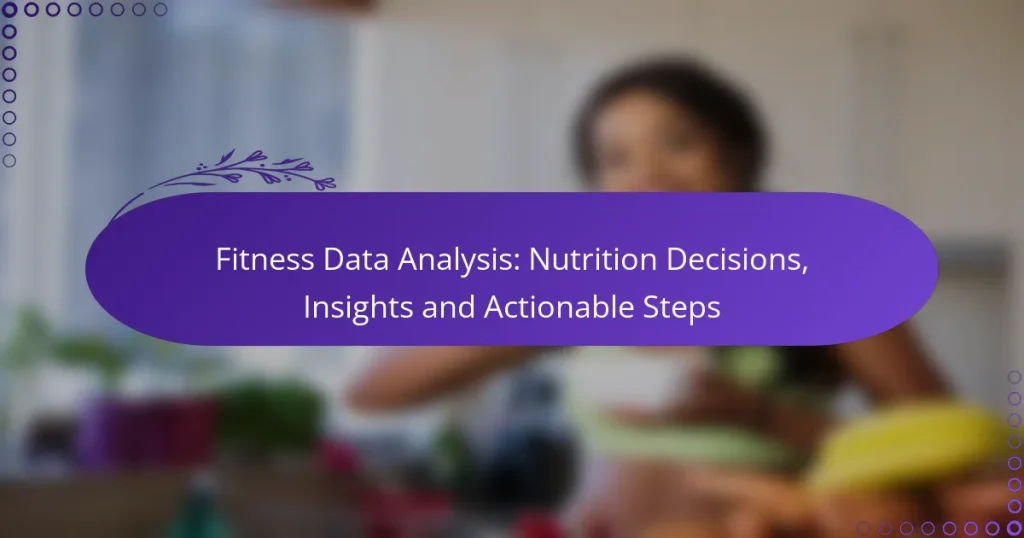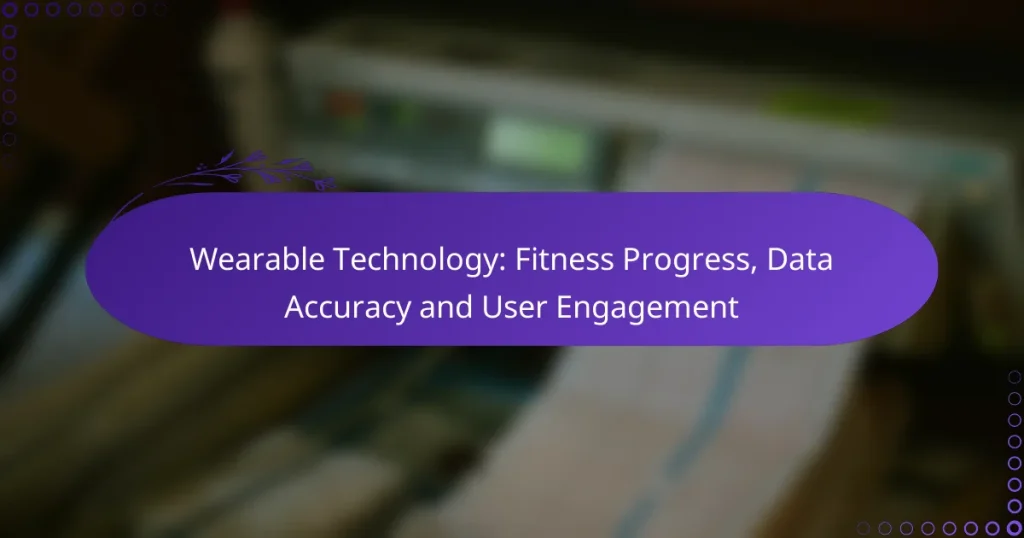Mindful nutrition plays a crucial role in enhancing fitness tracking by ensuring that your body receives the essential nutrients needed to achieve your fitness goals. By understanding the impact of your dietary choices on performance, you can make informed decisions that support your overall progress. Utilizing effective fitness tracking tools can help you monitor both your nutritional intake and physical activity, fostering healthier lifestyle habits.
Journals vs Apps: Mindful Nutrition Tracking, Usability and Engagement
Fitness Trackers: Data Collection, Accuracy and User Preferences
Fitness Data Analysis: Nutrition Decisions, Insights and Actionable Steps
Measurable Goals: Fitness Journey, Progress Tracking and Motivation
Community Support: Fitness Progress, Motivation and Accountability
Wearable Technology: Fitness Progress, Data Accuracy and User Engagement
How can mindful nutrition enhance fitness tracking?
Mindful nutrition can significantly improve fitness tracking by ensuring that your body receives the right nutrients to support your fitness goals. By being aware of what you eat and how it affects your performance, you can make informed choices that enhance your overall progress.
Improved energy levels
Mindful nutrition helps optimize energy levels by focusing on balanced meals that include carbohydrates, proteins, and healthy fats. Consuming whole foods like fruits, vegetables, and whole grains can provide sustained energy throughout the day, which is essential for effective workouts.
To maintain high energy levels, aim for meals that include complex carbohydrates and lean proteins. For example, a meal of quinoa, grilled chicken, and steamed broccoli can fuel your body for intense training sessions.
Better recovery times
Proper nutrition plays a crucial role in recovery times after workouts. Consuming the right nutrients, particularly protein and antioxidants, can help repair muscle tissue and reduce inflammation. This can lead to quicker recovery and less soreness.
Incorporating foods like salmon, nuts, and berries into your post-workout meals can enhance recovery. Aim to consume a balanced meal or snack within 30 to 60 minutes after exercising to maximize benefits.
Enhanced focus during workouts
Mindful nutrition can improve focus during workouts by providing the brain with essential nutrients. Foods rich in omega-3 fatty acids, antioxidants, and vitamins can enhance cognitive function and concentration, allowing for better performance.
To boost focus, consider including foods like walnuts, blueberries, and dark chocolate in your diet. Staying hydrated is also crucial; aim to drink enough water before and during workouts to maintain optimal cognitive function.
What are effective fitness tracking tools for mindful nutrition?
Effective fitness tracking tools for mindful nutrition help individuals monitor their dietary intake and physical activity, promoting healthier lifestyle choices. These tools can range from mobile apps to wearable devices, each offering unique features for tracking calories, nutrients, and exercise.
MyFitnessPal
MyFitnessPal is a popular app that allows users to log their food intake and exercise easily. With a vast database of foods, it provides nutritional information, making it simple to track calories and macronutrients. Users can set personalized goals based on their fitness objectives, whether it’s weight loss, maintenance, or muscle gain.
One of the key features is the barcode scanner, which simplifies logging packaged foods. Additionally, the app offers community support and challenges, which can enhance motivation and accountability.
Fitbit
Fitbit is primarily known for its wearable fitness trackers that monitor physical activity, heart rate, and sleep patterns. The accompanying app integrates nutrition tracking, allowing users to log meals and see how their diet impacts overall health. Fitbit devices can sync with MyFitnessPal for a comprehensive view of fitness and nutrition.
Fitbit also provides insights and trends over time, helping users understand their progress. Users can set reminders to stay active or drink water, making it easier to maintain mindful habits throughout the day.
Lose It!
Lose It! is a user-friendly app focused on weight loss through mindful nutrition tracking. Users can set weight loss goals and receive personalized daily calorie budgets based on their targets. The app features a food database and allows for easy logging of meals and snacks.
One standout feature is the ability to create custom recipes and track portion sizes, which is essential for accurate calorie counting. Lose It! also offers a social component, enabling users to connect with friends for support and motivation.
How to set up a progress monitoring system?
Setting up a progress monitoring system involves establishing a structured approach to track your fitness journey effectively. This system should include clear goals, relevant metrics, and tools for data logging to ensure consistent evaluation of your progress.
Define clear fitness goals
Defining clear fitness goals is essential for effective progress monitoring. Goals should be specific, measurable, achievable, relevant, and time-bound (SMART). For example, instead of saying “I want to get fit,” a clearer goal would be “I want to run 5 kilometers in under 30 minutes within three months.”
Consider breaking larger goals into smaller milestones. This can help maintain motivation and provide a sense of accomplishment as you reach each target. For instance, aim to increase your running distance by half a kilometer each week.
Choose tracking metrics
Selecting the right tracking metrics is crucial for assessing your progress. Common metrics include weight, body measurements, workout duration, and performance indicators like speed or strength levels. Choose metrics that align with your fitness goals.
For example, if your goal is to increase strength, track the weights you lift and the number of repetitions. If weight loss is your aim, monitor your weight and body fat percentage regularly. Aim for consistency in how and when you measure these metrics.
Utilize apps for data logging
Using apps for data logging can streamline your progress monitoring. Many fitness apps allow you to input your workouts, track your nutrition, and visualize your progress over time. Popular options include MyFitnessPal, Strava, and Fitbit.
When choosing an app, consider its features, user interface, and compatibility with your devices. Look for apps that allow you to set reminders for logging data and provide insights based on your input. Regularly reviewing this data can help you adjust your fitness plan as needed.
What are the benefits of combining nutrition and fitness tracking?
Combining nutrition and fitness tracking offers numerous advantages, including improved health outcomes and enhanced performance. By monitoring both diet and exercise, individuals can make informed decisions that lead to better overall wellness.
Holistic health insights
Tracking nutrition and fitness together provides a comprehensive view of your health. This approach allows you to identify patterns and correlations between your dietary habits and physical activity levels. For instance, noticing how certain foods affect your energy during workouts can guide your meal choices.
Utilizing apps or journals to log meals and workouts can reveal trends over time. You may discover that increasing protein intake boosts your recovery or that certain snacks lead to energy crashes. This data-driven insight can empower you to make healthier lifestyle choices.
Personalized workout plans
Integrating nutrition data into your fitness tracking can help tailor workout plans to your specific needs. For example, if you find that you perform better after consuming a balanced meal, you can schedule workouts around your eating patterns. This personalization enhances workout effectiveness and enjoyment.
Consider using fitness apps that adjust your exercise regimen based on your nutritional intake and progress. These tools can suggest modifications to your routine, ensuring that your workouts align with your dietary goals, such as weight loss or muscle gain.
Accountability and motivation
Combining nutrition and fitness tracking fosters accountability, making it easier to stay committed to your health goals. Sharing your progress with friends or joining online communities can provide additional motivation. When you track both aspects, you are more likely to stick to your plans.
To enhance accountability, set specific, measurable goals related to both nutrition and fitness. For instance, aim to log your meals daily while also completing a set number of workouts each week. This dual focus can keep you engaged and motivated, leading to sustained progress over time.
What criteria should you consider when choosing a fitness tracker?
When selecting a fitness tracker, consider compatibility with nutrition apps, battery life, and data accuracy. These factors significantly influence how effectively the device can support your fitness and nutrition goals.
Compatibility with nutrition apps
Ensure that the fitness tracker you choose can sync with popular nutrition apps like MyFitnessPal or Lose It!. This compatibility allows for seamless tracking of both physical activity and dietary intake, providing a comprehensive view of your health.
Check if the tracker supports integration with multiple platforms, as this can enhance your ability to monitor progress and make adjustments. Look for devices that offer open APIs or partnerships with various health apps.
Battery life
Battery life is crucial for consistent tracking. Many fitness trackers offer battery life ranging from a few days to several weeks, depending on usage and features. Choose a tracker that aligns with your lifestyle—if you prefer frequent updates and notifications, opt for one with a longer battery life.
Consider how often you are willing to charge the device. A tracker that requires daily charging might be less convenient than one that lasts a week or more, especially for those with busy schedules.
Data accuracy
Data accuracy is vital for effective fitness tracking. Look for devices that provide reliable metrics for steps, heart rate, and calories burned. Some trackers utilize advanced sensors and algorithms to improve accuracy, which can be particularly beneficial for serious athletes.
Read reviews and user feedback to gauge the accuracy of different models. Keep in mind that while no device is perfect, those that offer consistent performance across various activities are generally more reliable.


